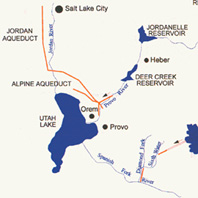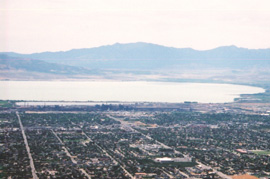Water Supply Update - Utah Lake (6)
Utah Lake is critical to water supplies in Utah and Salt Lake Counties.
LeRoy W. Hooton, Jr.
June 26, 2001
|
|
On June 25, 2001 the lake elevation was 1.90 feet below compromise with storage of 694,000 acre-feet. This is over 100,000 acre-feet less than last year at this same time. Like Commissioner Gardner, water users are concerned about the cumulative effect of a series of dry years on the water supply in the lake. Water saved this year will help keep more water in the lake for use next year.
Situated in Utah County, Utah Lake is the hub for the distribution water in Utah and Salt Lake Counties. The inflows of water include various local canyon streams and imported water from the Colorado River under the Central Utah Project. The primary non-imported sources of water are the Provo and Spanish Fork Rivers.
Utah Lake controls upstream storage on the Provo River under the State Engineer’s 1992 Utah Lake Water Distribution Management Plan. The Plan protects the primary storage rights in Utah Lake owned by the various mutual irrigation companies, municipalities and special water districts. The average inflow to the lake is 720,000 acre-feet and the average outflow is 346,000 acre-feet. One-half the water is lost by evaporation.
The lake, long a source of conflict between Utah and Salt Lake Counties, is subject to a compromise agreement made in 1885, which settled a long-standing dispute between the two counties. The compromise agreement was amended in 1986, after a number of wet years, when the lake flooded the adjoining lands around the lake. The new compromise level was established at an elevation of 4489.0455 and the total flow in the Jordan River would not exceed 3,400 cubic feet per second measured at 2100 South Street. When the lake is at compromise the storage capacity is 870,000 acre-feet.
The primary water rights amount to 175,588 acre-feet of water and the secondary 112,739 acre-feet. Four mutual irrigation companies, Salt Lake City, Jordan Valley Water Conservancy District and the Central Utah Water Conservancy District, hold the water rights. Five canals divert water from the Jordan River at the Jordan Narrows to farmlands within Salt Lake County. When there is insufficient natural flow from Utah Lake, water is pumped into the Jordan River by the Board of Canal President’s Lehi Pumping Station.
Salt Lake City depends on Utah Lake to provide “exchange water” to farmers with whom Salt Lake City has entered into exchange agreements dating back to 1888. Water diverted into the Jordan and Salt Lake City and East Jordan canals replaces water the city diverts from Little Cottonwood, Big Cottonwood and Parleys streams for municipal use. While the lake flooded in the early 1980s, it nearly dried up in 1992 the end of a 5-year drought. The lake dropped to 9 feet below compromise in late July 1992, cutting off the water supply to all water right holders.
|
|
In 1992, in order to meet its exchange agreement obligations, Salt Lake City released 38 cubic feet per second of treated municipal drinking water into irrigation ditches. That same year, the State Engineer implemented the Utah Lake Management Plan, reflecting the need to manage the lake with the growing demands on it. The early lake decrees did not reflect the growing municipal water demands on the lake’s tributaries with upstream diversions in Deer Creek and Jordanelle Reservoirs.
Utah Lake has experienced both wet and dry cycles. During wet cycles the lake’s elevations have risen and during dry cycles fallen. In the worst of dry cycles in the early 1930s and 1990s the lake was nearly drained. Much will depend on next year’s snowpack and run-off. But for this year, there appears to be an adequate supply in Utah Lake.
Salt Lake City is asking its customers to not water outside between 10 a.m. and 6 p.m. and reduce the amount of outside watering by 20 percent this year.

